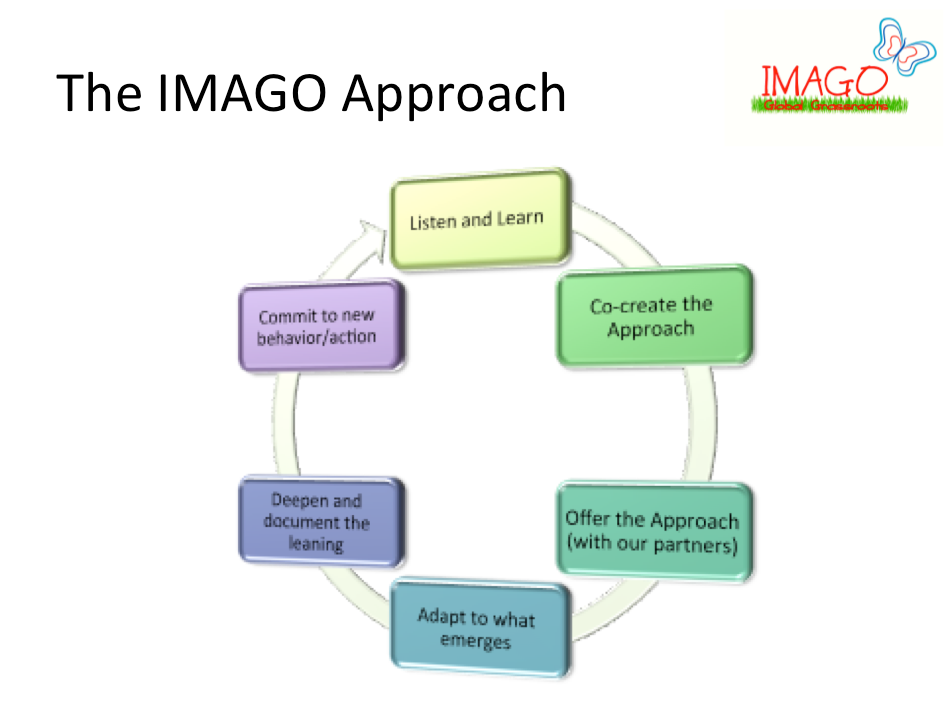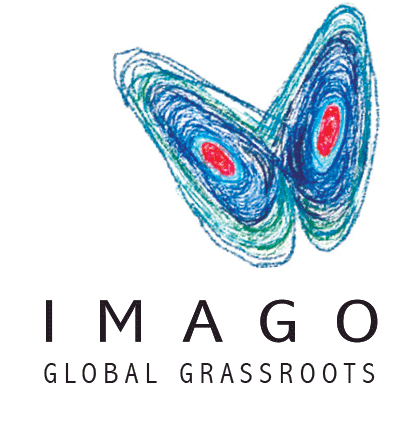Organizational Applications for Capacity Building
- juanito811
- 20 dic 2014
- 5 Min. de lectura
IMAGO believes each organization has unique strengths and capacities. We work with the wisdom that is already present to facilitate how organizations can discover their own next level.
We first listen and learn. Together, with the organization, we co-create approaches in “real-time” that make available ways members can see themselves. Our expertise is in facilitating these processes—and honoring your capacity to bring your own variations to these approaches.
Through activities designed to deepen and enhance communication as well as foster reflection and spark insight, we believe new learning emerges for all. Our aim is to co-create conditions for members to be directly invested in taking committed action towards what they most need next for themselves.
The activities and exercises in the following are from various sources and have been used by IMAGO to work with organization. Some materials have been created by IMAGO, while many others are directly from well-established resources. We invite our partners to use “reverse innovation” to translate and adapt these materials as needed to better meet the needs of your context…and continue the process is their own way.
FLAME Analysis
Flame Analysis, developed by the Dialogos Institute, is a process of personal and organizational reflection. The aim of the Analysis, at core, is to determine the degree of alignment between values and actions.
As a process, Flame Analysis involves the progressive dialogic exploration of key questions by members of an organization. Each element—Identity, Tone, Structure, and Action—is best considered on its own, though the elements are all ultimately interrelated. As most organizations are action-oriented, Flame Analysis flips this process and begins with Identity. Ideally, the selected questions for each element are first considered at the individual level. Small groups, preferably with no greater than five members, seek to reach consensus on the responses offered by each individual.
Once achieved (or not) the question is then further examined by the group-as-a-whole to discover areas of convergence and divergence within the organization. Through consensus or a broader trend analysis process (such as nominal group technique—a form of preference voting)—the “now” of the organization on each element is made more evident.
Flame Analysis requires sufficient time, strong facilitation, and openness by the organization to “feel the warmth, see the light, and (at moments) experience the
burn of the flame.

ARCHETYPAL Analysis
Archetypal Analysis is a methodology that is used to get a core leadership styles that influence individual and organizational effectiveness. Adapted from the work of Carl Jung but recognized as well as an element of Vedic Hindu tradition, archetypal analysis brings forward ways of working that present but are often left unspoken. At IMAGO, we use this approach to help get a glimpse of the “center of gravity” of leadership life and whether this particular style is perceived to be consistent with the current strategic dilemmas faced by the individual and the organization. This process may be used alone or as a way to get to deeper dimensions of “tone” on a team.
The steps in Archetypal Analysis are to:
Ask members to choose a place on the line where they tend to operate in the organization most of the time… It may be easier for each continuum (Lover to Warrior and Sovereign to Magician) to be taken one at a time.
Once placement on a particular line is completed a continuum, closer to one side or the other, the two points are joined in one of the quadrants.
It is then possible to ask members of the organization where they see the “group-as-a-whole” in terms of these archetypes.
At an advanced level, members can choose a behavior/goal where a different archetypal pathway may be useful and commit to prototype practice of the process.
The strength of this approach reveals the strengths and limitations of operating primarily from one archetypal leadership style. It promotes an atmosphere of inquiry and curiosity where the exploration of options and the creation of prototypes for action can be more readily developed.

BART Analysis Quick Organizational Check
BART Analysis, once learned, is a very fast way to choose the next step of in organizational strategy or figure out when something is not quite right.
At any given time, organizations face one or more BART issues to address. The purpose of the analysis is to determine which ones need to the most attention.
All elements of BART are interrelated but can be approached as single processes. The key is to determine which process or combination is priority at a given moment. This analysis informs action and can greatly enhance deliberative discussions and problem solving approaches.

THE (B)ART OF NOTICING
Noticing is a process of attending to greater layers and levels of the immediate moment. At the basic level, it is pausing to take in what can be perceived by all the senses. The process then becomes an invitation to note the quality of our internal state as well as the thinking and emotions present and associated with these perceptions.
The key to noticing is in the observing what is “more” and present. It is like opening your eyes to see something for the first time. The challenge of noticing is to move beyond what is familiar, including our cherished mental models, to see the world anew.
While noticing is primarily a practice of reflection and learning, it can be used to inform new action and provides opportunities to practice new behaviors.
Finally, noticing is related to BART analysis. In organizations, when noticing is practiced, it enhances the range of roles and expands the boundaries of conscious action.

ARRIVING AT THE IMAGO MOMENT
While the tools outlined reflect those used in some combination in many IMAGO capacity building exercises, what is not expressed is the importance of intuitive sensitivity to the ever-changing emerging organizational dynamic. As such, core to the IMAGO approach is continuous cycle of deliberative engagement where the elements include:
Listen and Learn
In this step of the process, IMAGO operates from the tenet that the wisdom of what is needed to address challenges within an organization already exists among its members. Through listening and learning, there is a translation of the various voices into a process that reflects the group’s wish and wisdom.
Co-create the Approach
We see co-creation as key to whatever approach that is used. While IMAGO may have models and expertise important for learning, we place a premium on working with the organization to attend to cultural nuances that will enhance how any intervention is placed forward.
Offer the Approach
While it may seem very straightforward to then offer a shared approach to learning, it is often the most challenging part of the process. Given that what is being offered may have never been done in this precise way by any party, there is “real time” learning that is taking place for all parties.
Adapt to What Emerges
It is often necessary “in the moment” to adapt the approach that is being used. This element of the process means that there must be tolerance for ambiguity and uncertainty for an optimal level of learning.
Deepen and Document the Learning
The process requires two levels of documentation. The first is actually documentation of what approach is ultimately used. The second element is adjusting this thinking and adapting the process for future use in other contexts.
Commit to New Behavior and Action
The end of the process is also the new beginning. A continuous cycle is present so that learning from the approach can be approached and steps to action, using specific goals are offered at the individual and collective level.
When these steps are kept in mind, the prospect of creative and innovative approaches to
organizatinal learning, capacity building and leadership effectiveness are often the result.














Comentarios